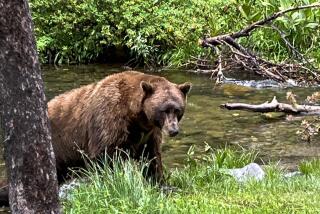Study helps untangle polar bear and brown bear genetics
Among those concerned about the fate of the polar bear, it’s thought that understanding the iconic animal’s genetics could help scientists figure out what will happen to the bears as the climate warms and their icy habitat shrinks.
There’s just one problem: pinning down the polar bear’s genetic history — including when and how it split away from its close relative the brown bear — has been tricky. Recent studies have concluded that polar bears are closely related to brown bears (a group that includes grizzlies). But they have arrived at widely varying dates for the species’ split. That’s because the blend of polar bear and brown bear genes scientists have found in bears can allow multiple interpretations of the species’ genetic histories.
Now a new paper, published Thursday in the journal PLOS Genetics, suggests a reason for some of the confusion: Researchers misunderstood the history of one particular set of bears in the mix, the brown bears living on Alaska’s Admiralty, Baranof and Chichagof (ABC) islands.
ABC island brown bears share genes with polar bears, which led scientists to think they were similar to the bears that would have been the ancestors of the polar bear. But scientists at UC Santa Cruz now think the story of the ABC bears goes the other way around — that they are the descendants of female polar bears who were the original inhabitants of the islands.
“It’s as if you were studying how humans are related to chimpanzees and were looking at DNA from some weird population of hybrid humans who had mated with chimps,” said UC Santa Cruz biomolecular engineer Ed Green, a coauthor of the study. “The bears that are confusing everything are these ABC island bears.”
The key to the new insight lay in figuring out that the portion of ABC island bear DNA that had the largest contribution from polar bears was the genetic material passed directly from mother to offspring. That suggests that female polar bears, stranded on the islands as ice receded at the end of the last glacial period, mated with generations of migrating male brown bears who swam to the island. Over time, most of the polar bear DNA was overrun by brown bear DNA, but the maternal polar bear DNA was harder to crowd out.
The new study’s lead author, UC Santa Cruz evolutionary biologist Beth Shapiro, worked on one of the earlier polar bear genetics papers, a study that concluded that all polar bears alive today descended from a female brown bear in Ireland. (You can read Los Angeles Times coverage of that study here.)
But looking at genome-wide sequences from a number of bears (including seven polar bears) for the current study, Shapiro and her colleagues found little variation among the polar bears — and no brown bear ancestry at all. Now she thinks that the Irish brown bears, now extinct, may have been like the ABC brown bears: a population of polar bears that were overrun by genetic contributions from brown bear interlopers.
Coauthor Green said that the new finding underscored “the wild things that can happen on an island,” and that the team would continue searching to see whether this kind of thing has happened on other populations and on other islands.
“The future will let us know if it was a freak thing on this island, or if it’s a first example of a wider phenomenon,” he said.
Follow me on Twitter: LATerynbrown







